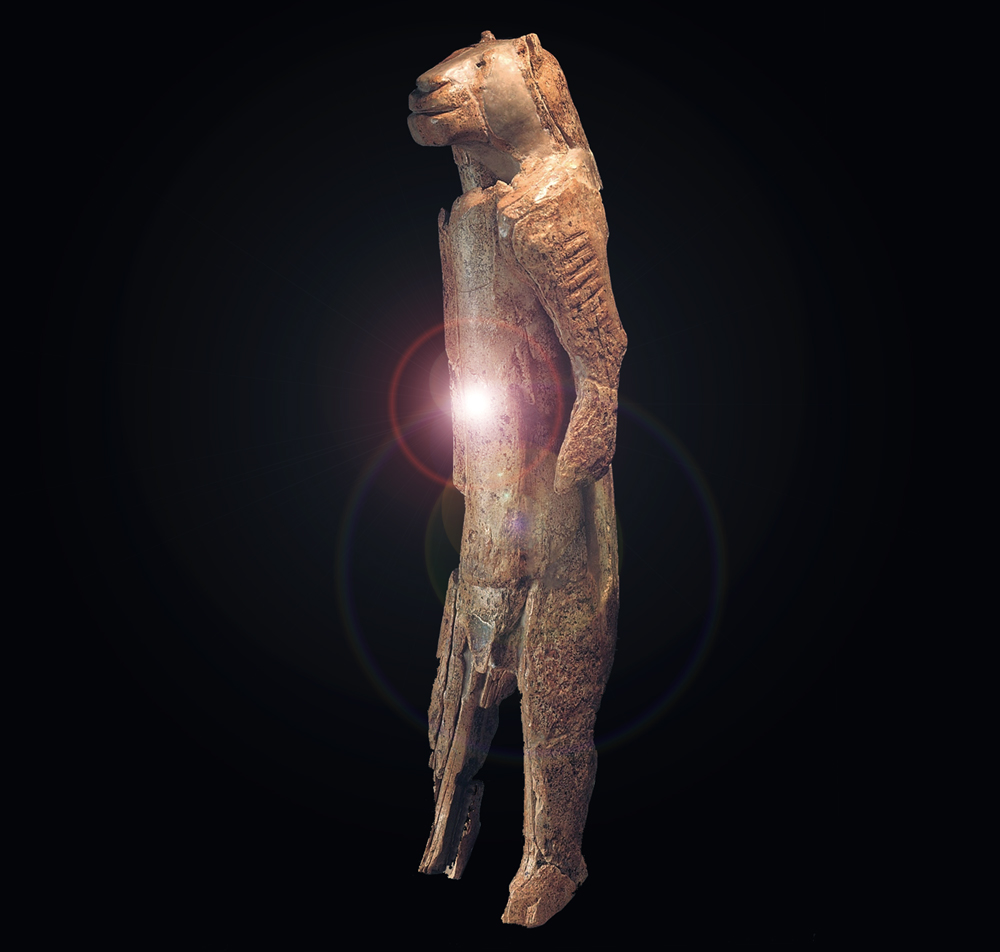


The Lion Man sculpture from the Stadel Cave, carved out of mammoth ivory, is now believed to be 40,000 years old based on carbon dating material from the same layer in which the sculpture was found. It is from the Aurignacian culture. It was carved using flint knives, burins and scrapers.

Given its age, this is one of the earliest examples of man imagining things that do not actually exist. Dr Jill Cook, Deputy Keeper in the Department of Prehistory & Europe in the British Museum, in her publication 'Ice Age Art: Arrival of the Modern Mind', describes this as the activity of a 'super brain'; what might have been 'an arcane archaeological discovery has in fact become a talking point for the field of neuroscience.'
The original artist was highly skilled, and familiar with the structure of the mammoth tusk. The form of the sculpture was conceived to make the best use of the characteristics of the ivory, such as the curve and the inner pulp cavity between the legs. It is estimated that the sculpture would have taken some 400 hours to carve, in other words, about 6 weeks.
As we may assume that this was a considerable length of time for a hunter-gatherer to devote to creating a sculpture we are probably right in concluding that the Lion Man was a very meaningful object.
It was discovered in the Stadel Cave in the Lonetal on the Hohlenstein Mountain, Germany, and is now in the Ulmer Museum, Ulm. Germany. The actual size of the piece is 28.1 cm tall, 6.3 cm wide and 5.9 cm thick. It was found in many pieces - over 200 fragments - and parts of the front of the body are missing. The stance and muscularity of the shoulders
suggest a man standing on tip toes with arms to his sides. The left upper arm is marked with incisions which might represent tattoos or scarring.
The leonine head faces forward in an alert stare emphasised by a powerful jaw line and upright ears. Does the sculpture represent a mythical, supernatural being, perhaps a deity? Is it a man wearing a lion headdress?
The Lion Man was made as an avatar of particular symbolic and social messages - messages that we can no longer read. But there may be another way of looking at the Lion Man.
Dr Ilse Vickers explores the links between mythology, religion and the psyche, and in this connection she is working on the dynamic relationship between depth psychology and Palaeolithic cave art. Regarding the Ice Age figurine of the Lion Man her thoughts went immediately to Aion, a Mithraic god of the Roman period, 2nd - 3rd Century.
Aion is depicted as a man with a lion head, encoiled by a serpent from the feet upwards, the serpent's head resting on the lion's head. He has two large wings, and in one hand holds a messenger's staff and in the other a thunderbolt. He is sometimes shown encircled by the symbols of the zodiac, connoting space and time.
Aion is the 'Lord of Ages', and is also known as Phanes, 'the shining one'. It is worth noting that he is a composition of a number of opposites. Here are some examples:
- Lion, symbol of power and eternal light versus serpent symbol of darkness/moonlight, borrowed light, and rebirth
- man versus God/spirit
- Time/space versus eternity
- mendicant versus king/God
- discrimination (thunderbolt) versus archaic or undifferentiated
Dr. Vickers goes on to say that as a figure embracing so many opposites, it suggests a personification of the Ground of Being. Is there a possibility that the Aion myth has its roots embedded in the Ice Age, that took form and evolved throughout prehistory and history?
The Portable Art of the Ice Age:
http://www.bradshawfoundation.com/sculpture/ice_age/index.php
Ice Age Art Gallery:
by Bradshaw Foundation
Friday 09 August 2024
by Bradshaw Foundation
Wednesday 24 July 2024
by Bradshaw Foundation
Thursday 04 July 2024
by Bradshaw Foundation
Monday 01 July 2024
by Bradshaw Foundation
Wednesday 20 March 2024
by Bradshaw Foundation
Tuesday 13 February 2024
by Bradshaw Foundation
Tuesday 13 February 2024
by Bradshaw Foundation
Thursday 01 February 2024
by Bradshaw Foundation
Tuesday 28 November 2023
by Bradshaw Foundation
Thursday 23 November 2023
by Bradshaw Foundation
Monday 20 November 2023
by Bradshaw Foundation
Tuesday 31 October 2023
by Bradshaw Foundation
Thursday 26 October 2023
by Bradshaw Foundation
Wednesday 20 September 2023
by Bradshaw Foundation
Monday 17 July 2023
by Bradshaw Foundation
Sunday 09 July 2023
by Bradshaw Foundation
Friday 09 August 2024
by Bradshaw Foundation
Wednesday 24 July 2024
by Bradshaw Foundation
Thursday 04 July 2024
by Bradshaw Foundation
Monday 01 July 2024
by Bradshaw Foundation
Wednesday 20 March 2024
by Bradshaw Foundation
Tuesday 13 February 2024
by Bradshaw Foundation
Tuesday 13 February 2024
by Bradshaw Foundation
Thursday 01 February 2024
by Bradshaw Foundation
Tuesday 28 November 2023
by Bradshaw Foundation
Thursday 23 November 2023
by Bradshaw Foundation
Monday 20 November 2023
by Bradshaw Foundation
Tuesday 31 October 2023
by Bradshaw Foundation
Thursday 26 October 2023
by Bradshaw Foundation
Wednesday 20 September 2023
by Bradshaw Foundation
Monday 17 July 2023
by Bradshaw Foundation
Sunday 09 July 2023
Friend of the Foundation











